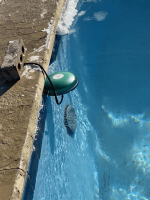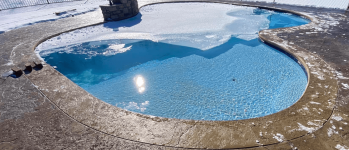I'm here to tell my tale of frozen woes and see what I can learn in the process.
Here in Texas, just South of Austin, temperatures have been dropping into low teens the past couple nights, staying below or near freezing during the day. Old Pentair single-speed pump has been running in Freeze mode 24-7. Worked fine protecting us against a good freeze last Winter. Yesterday, I came downstairs and noticed that the pool level was a good course of tiles lower than normal. Ran to side of house to look at equipment pad and saw water spouting 5-10 feet into the yard which was on it's way to being flooded. Turned off the pump and closed every valve. Pool was drained to just below the skimmers. One of the ball valves for a return had cracked, frozen solid from within. I then realized my first mistake.
Our equipment pad sits well below the level of the pool. We have 3 suction lines (1 for each Skimmer, 1 for the 2 Main Drains) and 3 pressure lines (1 feeds 4 return Jets, 1 feeds a "spray" jet facing up on stair platform and the other feeds a quick-connect jet for an old pressure-fed vacuum hose). These 6 plumbing lines stick up a good 1-2ft above ground (exposed) before hitting the valves at the equipment pad (see attached photo). So when the pump is OFF during a freeze, water is just sitting stagnant above ground below those valves at the equipment pad.
Well....we habitually leave the ball valves on the returns for the spout and the vacuum in the OFF position (first mistake). Having that valve closed meant that the exposed portion of that plumbing above ground was full of water yet not moving. This stagnant water in the closed return line must have frozen and then cracked the pipe just below the valve. During a freeze when pump is running in FREEZE mode, one must OPEN ALL VALVES.
I ended up draining the equipment, closing all valves and praying for the best overnight (low of 15). Since our equipment pad sits below the level of the pool, we can't drain equipment and then leave all valves open. If we do that, the pool will drain back into/out of the equipment. Therefore, I was forced to leave the equipment drained, all valves CLOSED, and electrical breaker off over night.
Not a surprise, since no water was moving, we woke up to another crack, this time the ball valve on the main Returns line. So we cut the pipes on the Returns and the Vacuum lines and they sure enough were frozen solid below the valves. New valves were installed and we spent hours melting ice in the above ground plumbing with heat guns until all three suction lines were flowing. We thought that we had thawed the 3 returns but when starting the pump we'd get no return action in the pool. Finally discovered my second mistake, the in-line Pentair Chlorinator had not been drained with the rest of the equipment and feed rate dial was set to OFF. So after getting that lid off, there was a solid mass of ice filling the Chlorinator and ulimately (likely) had trickled down and blocked the main PVC pipe just below the chlorinator, pre-return valves. At this time it was dark (tonight) and I had no choice but the drain everything again and throw a tarp over it. Likely will wake up tomorrow with new cracks at the valves. It seems that once that pump stops running and everything that has water in it freezes you basically just have to wait for a good thaw. During a freeze when pump is frunning in FREEZE mode, one must open the chlorinator feed valve. If equipment needs to be drained, one must drain the chlorinator.
So, in summary, after the initial break in the plumbing was discovered, resulting in our inability to run the pump overnight, I was basically in the power outage scenario that so many people fear...circumstances where the water cannot be continuously cycled through the plumbing.
Will all of that said, I would love to hear any additional advice regarding this scenario...hard freezes where pool equipment pad is well below the level of the pool. Aside from winterizing (closing) the pool, what other steps could I be taking? I've read that "wrapping" the exposed plumbing doesn't really work so well during longer, continuous freezes. I really don't know what to do to protect ourselves in the future since any time that we end up unable to use the pump during freezing conditions, I really can't clear the plumbing lines of water between the pool and the pad. I suppose that I could bury the plumbing lines with dirt up to the valves. Considering how the water was spraying out from the initial break, if I had been utilizing a space heater or light bulb to generate heat under the tarp I wonder what type of fire hazard those circumstances could have presented.
It's likely that had I not make mistake 1 and mistake 2 that my pump would have continued running 24-7 and gotten us through the freeze without issue.
Here in Texas, just South of Austin, temperatures have been dropping into low teens the past couple nights, staying below or near freezing during the day. Old Pentair single-speed pump has been running in Freeze mode 24-7. Worked fine protecting us against a good freeze last Winter. Yesterday, I came downstairs and noticed that the pool level was a good course of tiles lower than normal. Ran to side of house to look at equipment pad and saw water spouting 5-10 feet into the yard which was on it's way to being flooded. Turned off the pump and closed every valve. Pool was drained to just below the skimmers. One of the ball valves for a return had cracked, frozen solid from within. I then realized my first mistake.
Our equipment pad sits well below the level of the pool. We have 3 suction lines (1 for each Skimmer, 1 for the 2 Main Drains) and 3 pressure lines (1 feeds 4 return Jets, 1 feeds a "spray" jet facing up on stair platform and the other feeds a quick-connect jet for an old pressure-fed vacuum hose). These 6 plumbing lines stick up a good 1-2ft above ground (exposed) before hitting the valves at the equipment pad (see attached photo). So when the pump is OFF during a freeze, water is just sitting stagnant above ground below those valves at the equipment pad.
Well....we habitually leave the ball valves on the returns for the spout and the vacuum in the OFF position (first mistake). Having that valve closed meant that the exposed portion of that plumbing above ground was full of water yet not moving. This stagnant water in the closed return line must have frozen and then cracked the pipe just below the valve. During a freeze when pump is running in FREEZE mode, one must OPEN ALL VALVES.
I ended up draining the equipment, closing all valves and praying for the best overnight (low of 15). Since our equipment pad sits below the level of the pool, we can't drain equipment and then leave all valves open. If we do that, the pool will drain back into/out of the equipment. Therefore, I was forced to leave the equipment drained, all valves CLOSED, and electrical breaker off over night.
Not a surprise, since no water was moving, we woke up to another crack, this time the ball valve on the main Returns line. So we cut the pipes on the Returns and the Vacuum lines and they sure enough were frozen solid below the valves. New valves were installed and we spent hours melting ice in the above ground plumbing with heat guns until all three suction lines were flowing. We thought that we had thawed the 3 returns but when starting the pump we'd get no return action in the pool. Finally discovered my second mistake, the in-line Pentair Chlorinator had not been drained with the rest of the equipment and feed rate dial was set to OFF. So after getting that lid off, there was a solid mass of ice filling the Chlorinator and ulimately (likely) had trickled down and blocked the main PVC pipe just below the chlorinator, pre-return valves. At this time it was dark (tonight) and I had no choice but the drain everything again and throw a tarp over it. Likely will wake up tomorrow with new cracks at the valves. It seems that once that pump stops running and everything that has water in it freezes you basically just have to wait for a good thaw. During a freeze when pump is frunning in FREEZE mode, one must open the chlorinator feed valve. If equipment needs to be drained, one must drain the chlorinator.
So, in summary, after the initial break in the plumbing was discovered, resulting in our inability to run the pump overnight, I was basically in the power outage scenario that so many people fear...circumstances where the water cannot be continuously cycled through the plumbing.
Will all of that said, I would love to hear any additional advice regarding this scenario...hard freezes where pool equipment pad is well below the level of the pool. Aside from winterizing (closing) the pool, what other steps could I be taking? I've read that "wrapping" the exposed plumbing doesn't really work so well during longer, continuous freezes. I really don't know what to do to protect ourselves in the future since any time that we end up unable to use the pump during freezing conditions, I really can't clear the plumbing lines of water between the pool and the pad. I suppose that I could bury the plumbing lines with dirt up to the valves. Considering how the water was spraying out from the initial break, if I had been utilizing a space heater or light bulb to generate heat under the tarp I wonder what type of fire hazard those circumstances could have presented.
It's likely that had I not make mistake 1 and mistake 2 that my pump would have continued running 24-7 and gotten us through the freeze without issue.
Attachments
Last edited:








